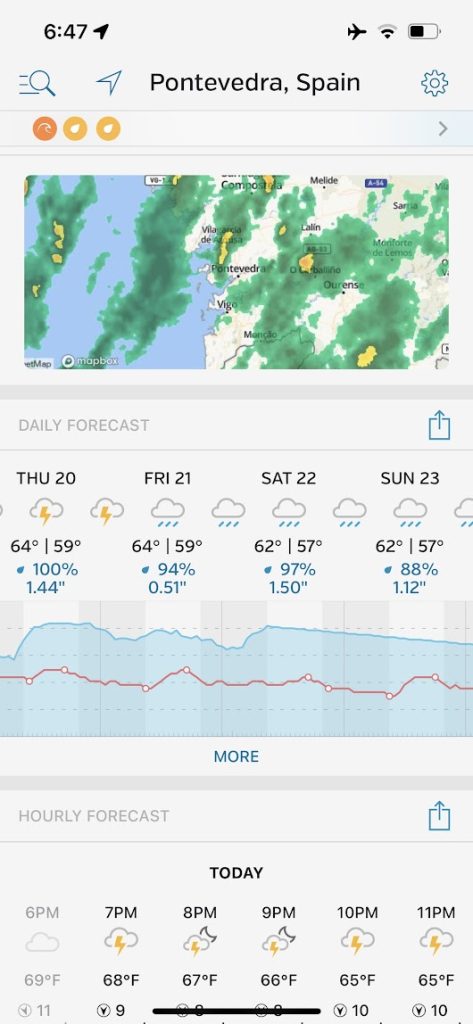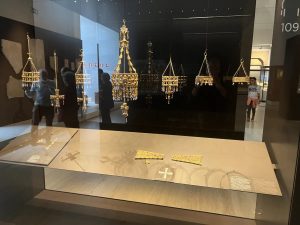Trip Overview Note
Our visit with José and María was a fitting finale for Phase 1 of our EuroTrip, which I call the “social phase”. The remaining three phases of our trip are:
Phase 2: Stay in Galicia for a combination of regional travel and working on some personal and professional goals for about a month. Ourense is the preamble to a 25 day stay in Pontevedra. The other big difference with Phase 2 is that it’s just Lyn and me for 25 days straight with no additional rendezvous plans with friends or family. We didn’t intentionally plan to see four different sets of friends during Phase 1 but it worked out that way and we had a blast doing it. Phase 2 is time to nurture the introverted side of our personalities and to catch up some tasks and planning.
Phase 3: Fly to Croatia for the main purpose of departing the European Union’s “Schengen Area” to stop the clock on our 90-day tourist visa. We plan to distribute our time across four different towns. Like Galicia, we will get some personal work done as well, interlaced with exploring as the weather permits. Croatia’s cliate is epic in the summer time. We’ll see if it rains more or less than Galicia in the winter. Hard to believe it would be more.
Phase 4: Return to southern Spain for the holidays, which will include our three kids flying in to join us in Sevilla. This will be our last hurrah before returning to life in the U.S. and finding new careers.
Phase 4.1: One week in London to manage our Schengen clock again and to facilitate returning to the U.S. on a discount airline.
Total travel time will be 126 days, including 89 days in Schengen Area countries.
We gave ourselves one day of buffer in case of flight delays. Breaking the 90 day Schengen visa limit is kind of liking making my mom angry; you aren’t exactly sure what the consequences would be, but you really don’t want to find out either. In our research, the enforcement and the penalties seem to vary by country (and perhaps by the nationality of the offender). It also seems to be more strictly enforced the farther north you go. We intend not to find out though. I won’t get into the politics of Brexit, but if it has any silver lining, this might be it.
Writing that last paragraph reminded me of a guy I saw here in Spain wearing a sweatshirt with the image of Muhammad Ali and one his his many famous quotes: “Don’t count the days – make the days count.” The Schengen rule makes it kind of necessary to count the days, but I fully appreciate that it’s the quality of how we spend the time here that matters most. Thanks, Muhammad Ali; your spirit is alive in Spain.
In a way, our visit to Valencia felt like it could have been a logical stopping point for what would have been an action-packed and highly rewarding five week trip to Europe. In our original concept, though, now is the time in our life where all of the factors align to keep traveling a little longer. Our kids have managed to stay out of the hospital or jail. Our pets are in good hands with (great) friends. The Navy crated up our earthly possessions and is storing them somewhere in a Hampton Roads warehouse for up to year. Our parents are healthy. We have no mortgage, no utilities, and no lawn to mow. Not only do we have no jobs to lose, but the Navy retirement system has perversely begun giving me a monthly “retirement” allowance for doing absolutely nothing. Finally, feeding and housing two people is a piece of cake (“pan comido” as they say in Spain) after years of carting kids along on vacations. And for better or for worse, our travel expenses are far less bruising than the trends on Wall Street of late. Why not keep going?
Ourense, Galicia
With our arrival to the northwest of Spain, two things are already very different. One is the weather; our arrival to Galicia has coincided with a very rainy period although in Ourense we had a few sightings of the sun between bands of rain . The other is the late sunrise and the structure of the daily routine. Galicia sits in the westernmost part of Spain at eight degrees WEST of the prime meridian, but it artificially follows the same time zone as the rest of Europe (it’s the same time here as in Budapest at 19 EAST and Warsaw at 21 EAST). That’s 30 degrees of longitude covering a single time zone!
As a result, the sunrises here are late. For example, sunrise on October 20th was at 0853 in the morning, making it dark as night at 8:30 in the morning. With no reason to get up and no sunlight to spark our senses, we have been sleeping much later (and staying up much later) in addition to having less structured activity each day. Some relief is in sight and our clocks will “fall back” from daylight savings on October 30th, so sunrise will be at the somewhat less ridiculous hour of 0800.
During our time in Barcelona and Valencia, we stayed busy and socially engaged right up to the moment we stepped onto the train for Galicia . This made our sudden change of tempo feel even more abrupt when we arrived to our hotel in Ourense. Fortunately, neither Lyn nor I have previously been to Oursense so the adventure of a new city helped keep alive our spirit of adventure. We booked three nights in Ourense with the idea of seeing this part of Galicia before arriving in Pontevedra where we have an apartment lined up for 25 straight days.
Ourense made sense as a stopover point for two reasons.
The first reason is that Ourense lies on the high speed train line between Madrid and Santiago de Compostela and we would have had to change trains there anyway. We considered stopping over in Santiago de Compostela but figured we’d have a chance to visit again; better to see a place where we don’t expect to return. Second, Ourense is known for having natural thermal springs, which seemed like something fun to check out. We made this plan before the Blue Lagoon experience in Iceland and before the “sport hotel” spa experiences of Austria, so it was just a bit of luck that we put Oursense into our plan and were able to continue the theme of thermal recreation.
Ourense (like many Spanish cities) also has a famous cathedral, in addition to both an old Roman bridge and a new “Millenium” bridge. We visited all of these while exploring this regional capital. Ourense had a lot more to offer than we expected and our three days there were an excellent first taste of Galician culture (which is warm), Galician cuisine (which is generous) and Galician weather (which is wet).
During our two full days in Ourense, we managed to hit the thermal baths once each day.
The first day, we went to the publicly operated bath which was free of charge and overseen by the Spanish equivalent of the city Parks and Rec, including supervisors to enforce rules and provide first aid. The second day we visited a private thermal bath, which cost 5 Euro per person and was designed with a Japanese onsen theme, but more so in architecture than in etiquette. The entrance fee also included some additional services not provided at the public bath next door, such as a locker, showers, and a restaurant.
Both the public bath and the private bath imposed strict prohibitions on taking photographs of the baths. We suspect this policy is designed to make patrons feel more comfortable and to avoid gawking tourists from photographing people in their swimsuits. The public bath is just below a footbridge and we managed to get one photo from a distance to share a sense of what these baths are all about. We did not get pictures at the Japanese bath, which is unfortunate because it is somewhat more visually appealing. Neither of them blow your socks off visually like the Blue Lagoon in Iceland but the water was warm and the experience was relaxing. Plus, you can’t beat the price at either free or at 5 Euro.
These spas are spread along the north side of the Minho (also written as Miño) River. At the tourist office, they gave us a map showing the four main thermal baths but it was not drawn to scale. The public bath is at the far left and the “Japanese” bath (called Terma de Outariz) is just to the right of the footbridge. From the bridge at the far right to these baths, it’s a 4+ km (2.5 mile) walk along the river. If you give Lyn a choice on how to get somewhere, she will opt for walking every time, so not only did we enjoy the baths on their own merit but also because it concluded a three miles walk from our hotel.
On our second visit, we made use of the little bus that looks like a “tourist train” instead of walking the 3 miles back to town, but it followed the same bumpy foot path as what we had been walking on and, wow, did we wish we had opted to walk. The “tourist train” didn’t move much faster than a walking pace because it had to slow down for all the big bumps (it also hit plenty of little bumps) and that train was not designed for non-flat terrain. It was jarring and uncomfortable the entire way.

Our visit fittingly began with a wet nighttime walk from the train station to our hotel (just over a mile). We could have taken a taxi but we packed for all weather and that would have been consistent with the spirit of our adventure. We were rewarded with discovering the Millennium Bridge. It’s always more fun to discover the things you didn’t expect than the ones you came to see.
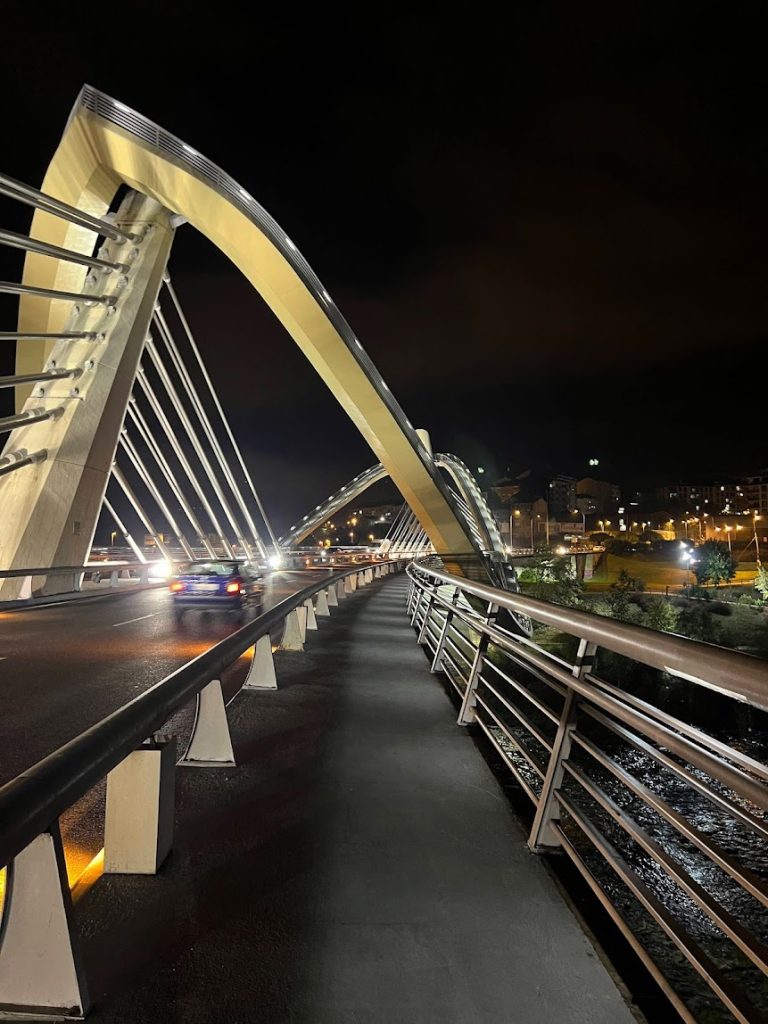
You’ll this bridge again further down in the daylight but it made a striking first impression on our walk from the train station to our hotel. In addition to having two lanes of car traffic in each direction, the bridge has a symmetric wave shaped walkway strictly for pedestrian use. If you are willing to climb the 100 steps, you get vantage points both looking up at the belly of the bridge and looking down from the very top on either end. The bridge has a total four stairways to the top (two on each end). Their only function is to offer a great viewpoint. You could also use the stair way to cross to the other side of the road, but that’s a lot work.

This is one of the four stairways to the top. Its only function is to offer a great viewpoint. It meets the other stairway at the top, making this a physically taxing alternative for a chicken to get to the other side of the road.

Not many things can compel Lyn to break the rules, but photographic journalism is one of them. This photo is from a discrete vantage point which doesn’t capture the size of the thermal springs fully. This was the public path and was pretty much a waste deep wading pool with a gradual incline. It had a second pool below (not shown) that was about 10 degrees hotter. It also had two pools that were completely drained for the off-season. In total, this pool had about 15 bathers on a Tuesday afternoon. If anyone thinks the “no camera” rule was because there’s something worth seeing, don’t strain your eyes too much. It was mostly old people and everyone was wearing their suits. You can see the far side of the foot bridge on the left side of the photo. We walked to the springs on the north side of the river and crossed the footbridge to walk back on the southside. The Minho flows mostly west and a bit south at Ourense and eventually becomes the northern border between Portugal and Spain.

The second photo below was taken from the footbridge which is outside the jurisdiction of the Parks and Rec “no camera” rule. You can see the second pool just behind the trees in the middle and one of the two empty pools in the lower left. Not the most picturesque hot springs in the world, but it felt great and it was free.
Catedral de Ourense
Ourense Cathedral is definitely something to see. It was built in 1220 so the age of this structure is impressive on its own. Part of the church is undergoing renovation (it is encouraging to see Spain’s treasures being preserved for future generations) so we were not able to get good photographs of the “Portico of Paradise” which is one of the signature things to see inside the cathedral. We saw it but the nearby scaffolding made photography difficult. This portico was built by student of Master Mateo who did the “Portico de la Gloria” at the cathedral in Santiago de Compostela, so we look forward to comparing the work of the master and the students when we visit Santiago de Compostela.

In the audioguide, one of the underlying themes is that Ourense and Santiago de Compostela were rivals of a sort over the centuries. In the asymmetries of market competition and brand recognition, however, nearly everyone has heard of Santiago de Compostela due in large part to it being a pilgrimage destination on the associated “El Camino” path. Meanwhile, the cathedral at Ourense is comparably grand and equally historic but gets a lot less visitors each year.
The current cathedral was completed in 1220 but the site dates back to the 6th century. The original churches built prior to 1220 were apparently destroyed by a combination of Viking raiders and Moors at successive points in the Middle Ages. Tough times.


Upon entering the cathedral, the first place the audioguide takes you is the “Tesoro” which is basically a museum of the catherdral’s treasures and relics.


This book is known as the “Aurensian Misal” . It was hand written over 500 years ago in 1494. Some believe it is the oldest written book in Galicia. It predates the printing press so the entire book was manually produced in a beautiful and precise font.
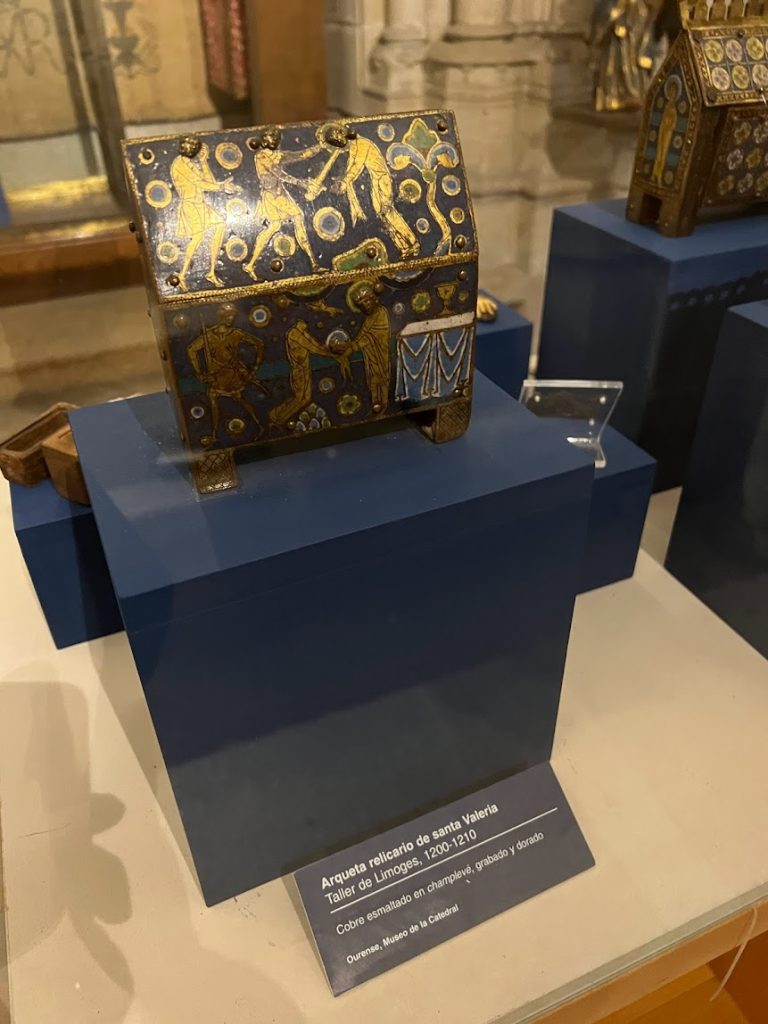

The box on the left (a small chest for holding relics) is even older than the book, dating from 1200, making it over 800 years old. On the right, among the more surprising items in the Cathedral’s Tesoro (Treasury) museum, according to the label plate, the bone belonged to Mary Magdalene (as in the faithful follower of Jesus). Specifically, the bone came from her foot.
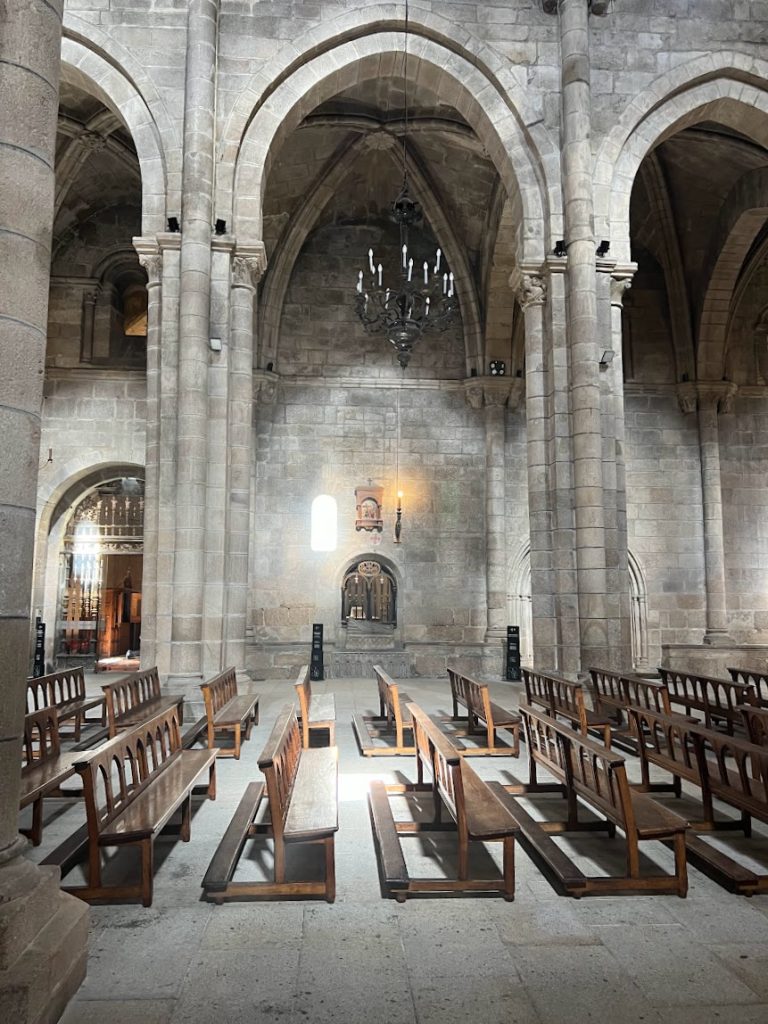
If you have read “Pillars of the Earth” by Ken Follett, Ourense Cathedral feels very much like a Tom Builder kind of place. View over the town from the catherdral’s tower. I had to take this photo through a protective screen so it’s not the best angle.

View over the town from the catherdral’s tower. I had to take this photo through a protective screen so it’s not the best angle.
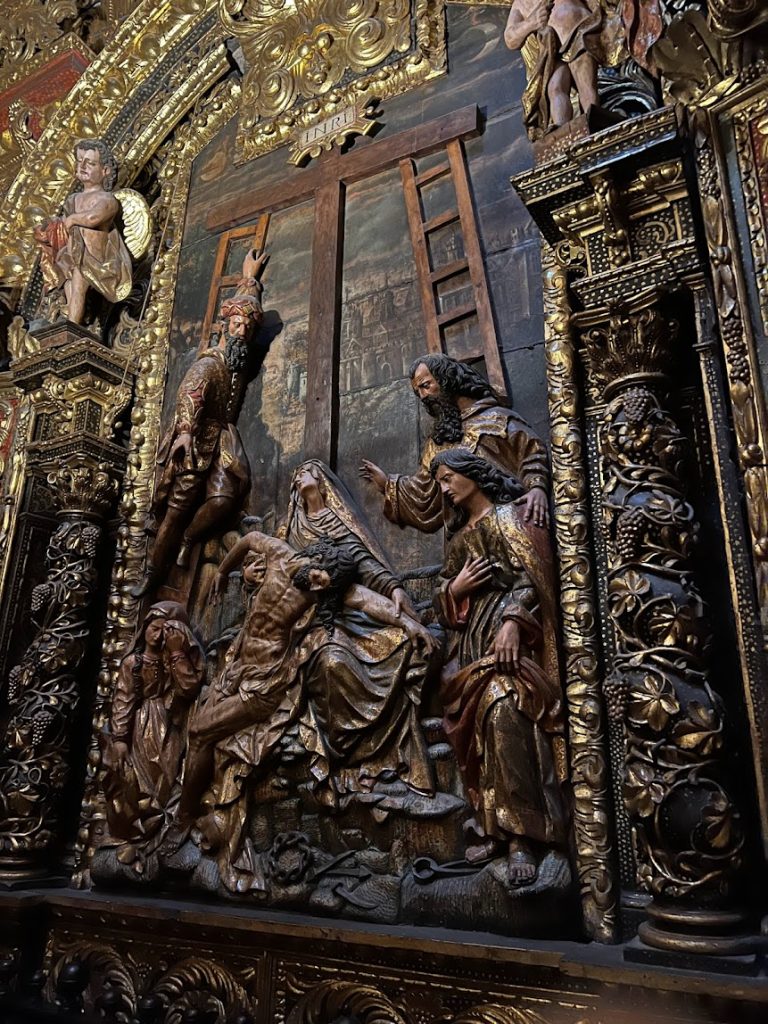
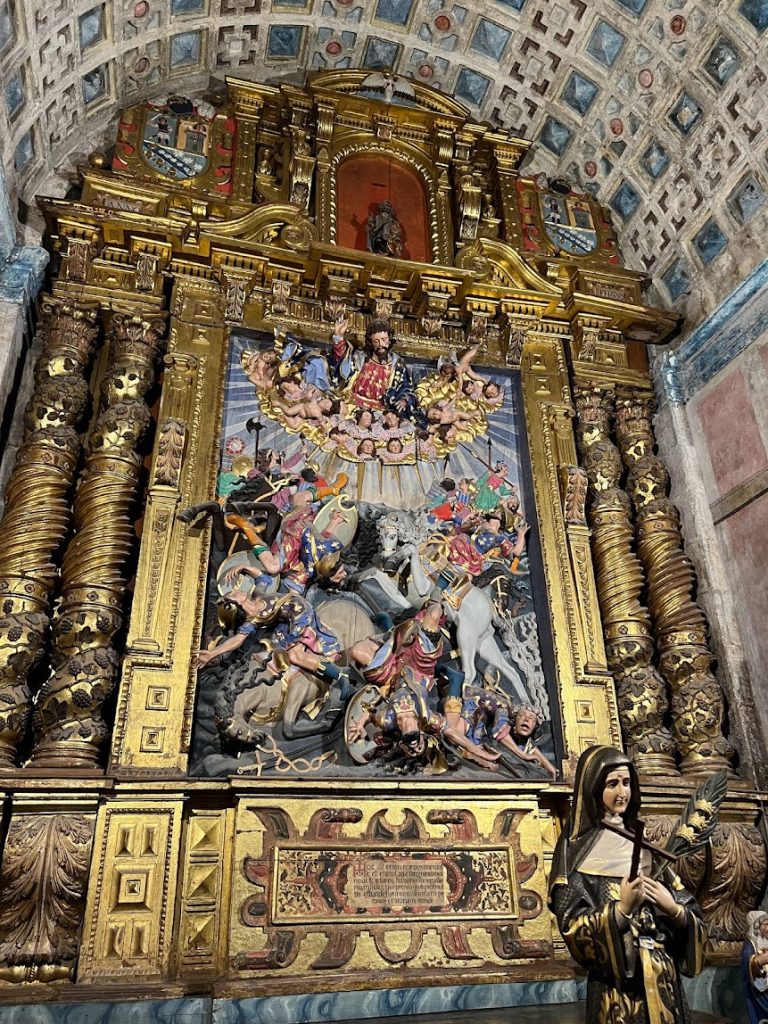

Like many of the churches in Europe, Ourense’s cathedral has a number of smaller chapels, each with its own design and purpose. The first one (left) was very elaborate with dark relief offset by a lot of gold, creating a very solemn mood. By contrast, a smaller side chapel (middle and right) was painted with vivid bright colors and almost feels like an animated scene in 3D relief. I don’t recall the backstory but the guy falling from his horse and in the process of hitting the ground is a vivid, almost cartoon like, contrast to the mood of the other chapels.

The main altar dates from the early 1500s and depicts the notable events in the life of Jesus and reads almost like a massive graphic novel from the top left to the lower right. This altar also highlightsSt Martin of Tours who is the patron saint of the cathedral and the Assumption of Mary.

Looking from the far side of the altar toward the back of the cathedral. On the right, you can see the a protective barrier camouflaging the scaffolds for renovation work in progress. This angle also brings to life the “pillars of the earth” image and boggles the mind how they built this cathedral in the 1200s.
Bridges of Ourense
We had a couple breaks in the weather. On our first walk to the thermal bath, we spent some more time on the Millennium Bridge and took a bunch of photos.
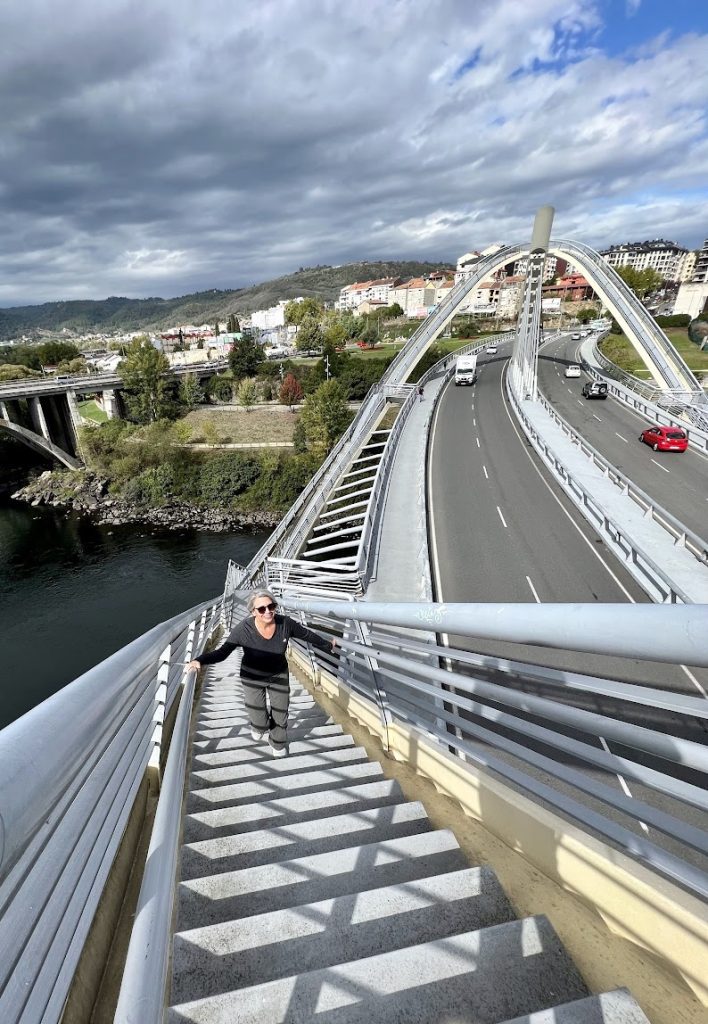

In the background, the next bridge upstream is Ourense’s “Roman Bridge”. This bridge was actually re-built since Roman times but it sits in the same spot and has mostly the same architecture as the original Roman bridge. It is reserved for pedestrian traffic (and the tour train). You can also see the little “tourist train” that we will end up riding the next day; it Doesn’t look like a jarring and violent experience from this vantage point.

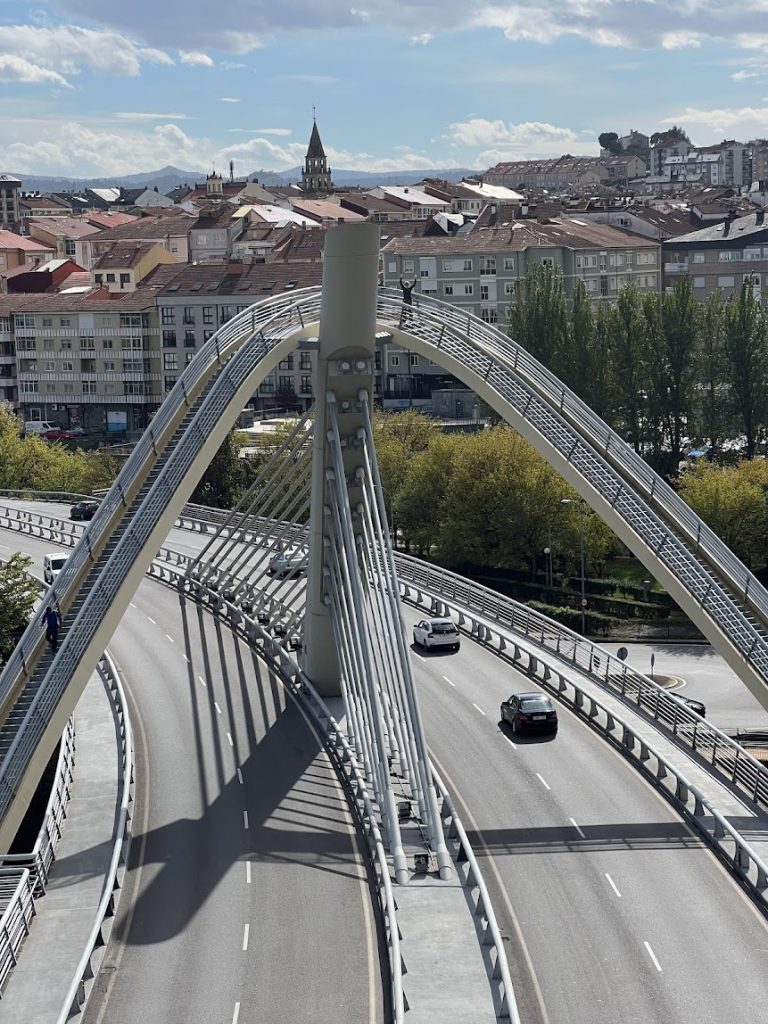
Waving to each other from opposites ends. Both of us out of breath from the climb.
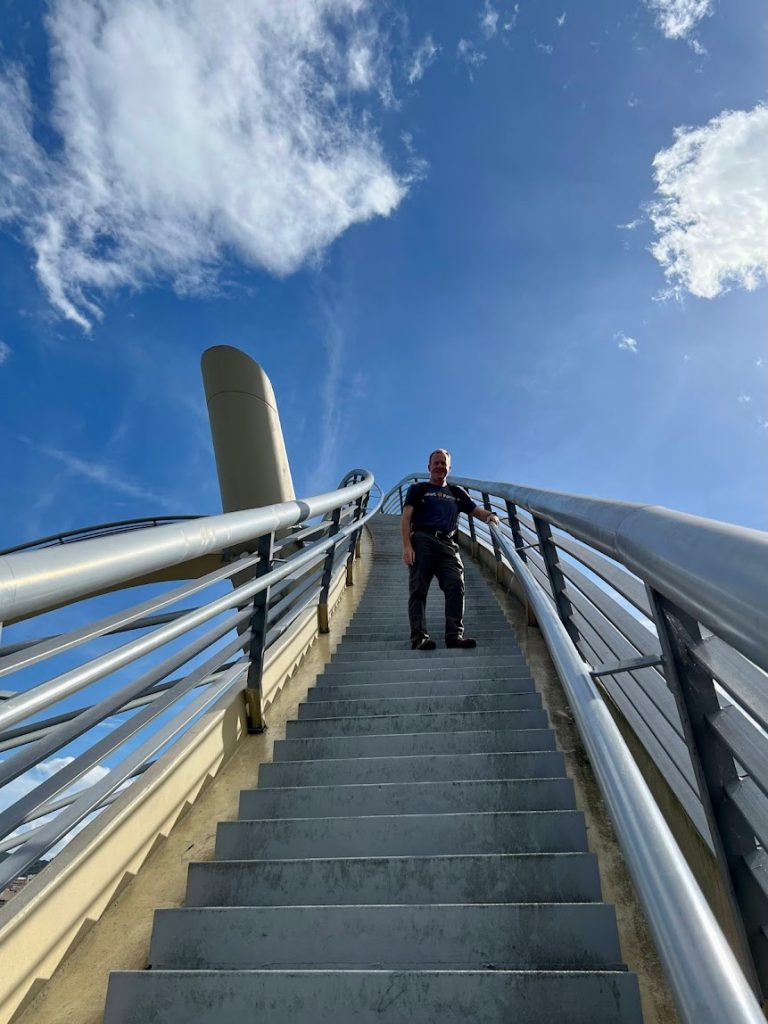


Coming down; the walkway is a loop so you can cross over to get to the opposite side (if you are in good shape). In the middle is the little “tourist train” that we will end up riding the next day. Doesn’t look like a jarring and violent experience from this vantage point. Millenium Bridge is a beautiful and stark contrast to it Roman neighbor upstream.

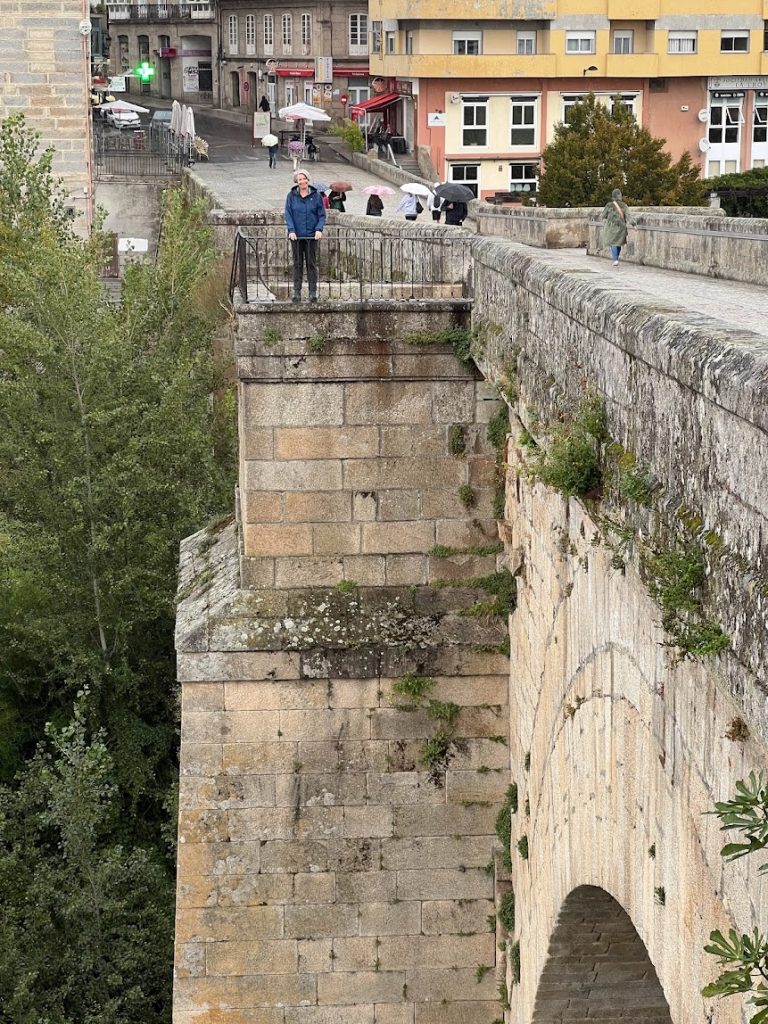
Look at me, Dad! I’m standing by a Roman bridge.

We are learning that these signs are common in most Spanish cities.

Food in Ourense
One of our more memorable dining experiences was stepping into a restaurant that looked almost deserted from the outside and being taken to a back room where a tour group of Spanish senior citizens were having a feast. It was some kind of tour group but it felt very much like the meal was as important as seeing the sights of Ourense. The Spanish know how to enjoy food.

Our meal was great, too!
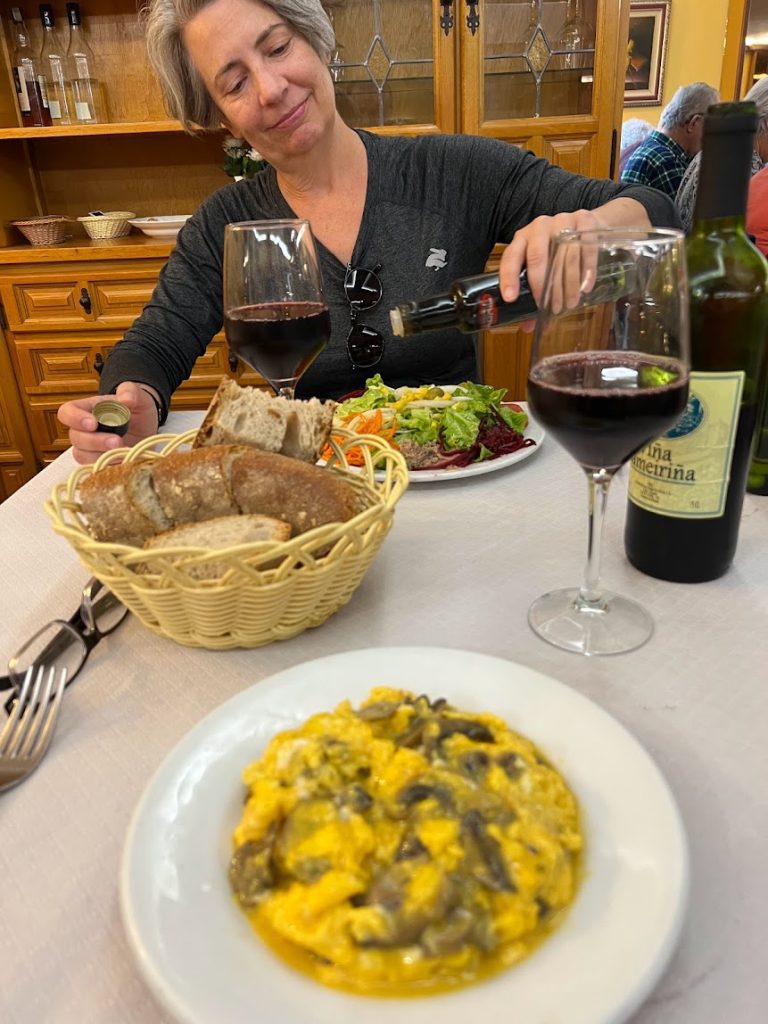
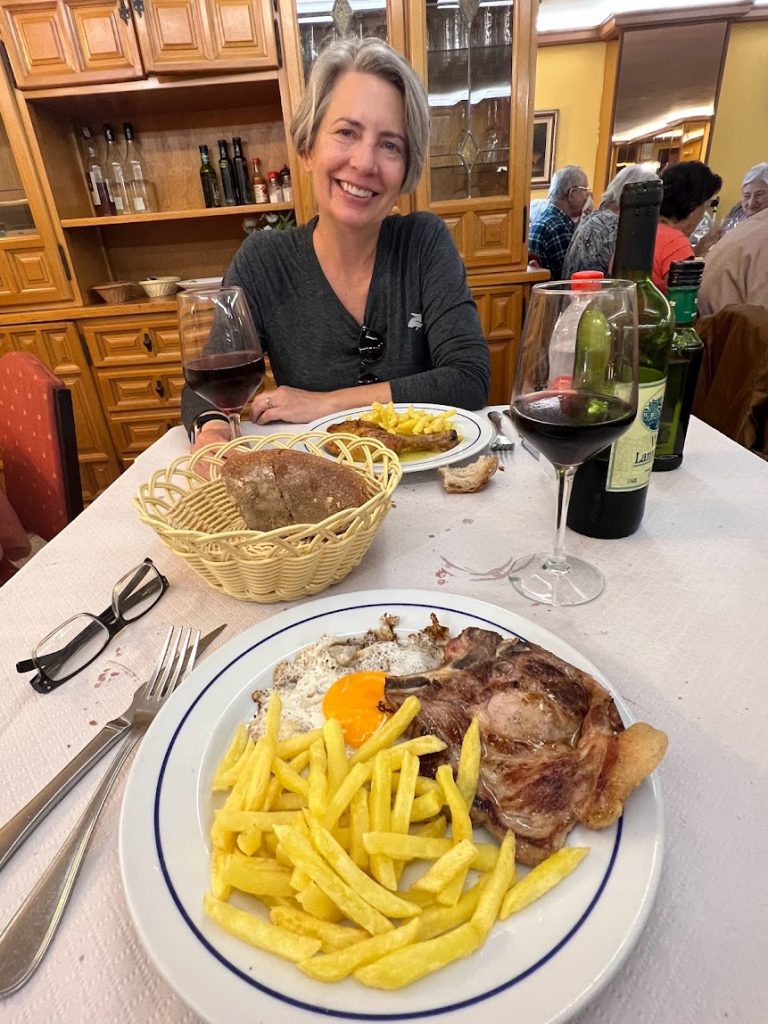
Jose told us Galicia is know as the “land of buen comida” and we started finding out what he meant by that. Just a few photos to share below. 1. Squid served on potatoes. 2. Scallops are served on their shells and still connected. These were the best scallops we ever had. 3. This was a salad Lyn ordered, notable for the heaps of grated cheese and generous olive oil. 4. Vermut is a thing in Galicia, only here they call in Vermu. 5. Mushrooms, tomato, and guacamole on toast for breakfast. 6. Coffee culture is alive in Galicia.






Finishing our time in Ourense
Ourense is an interesting city with a lot of character. In addition to the springs, the cathedral, and the bridges, we enjoyed the mood of the city and its unique character. Similar to the statue we saw in Pedreguer, we came across a sculpture honoring the traditional role of women in Spanish society. Everyone loves their grandma.


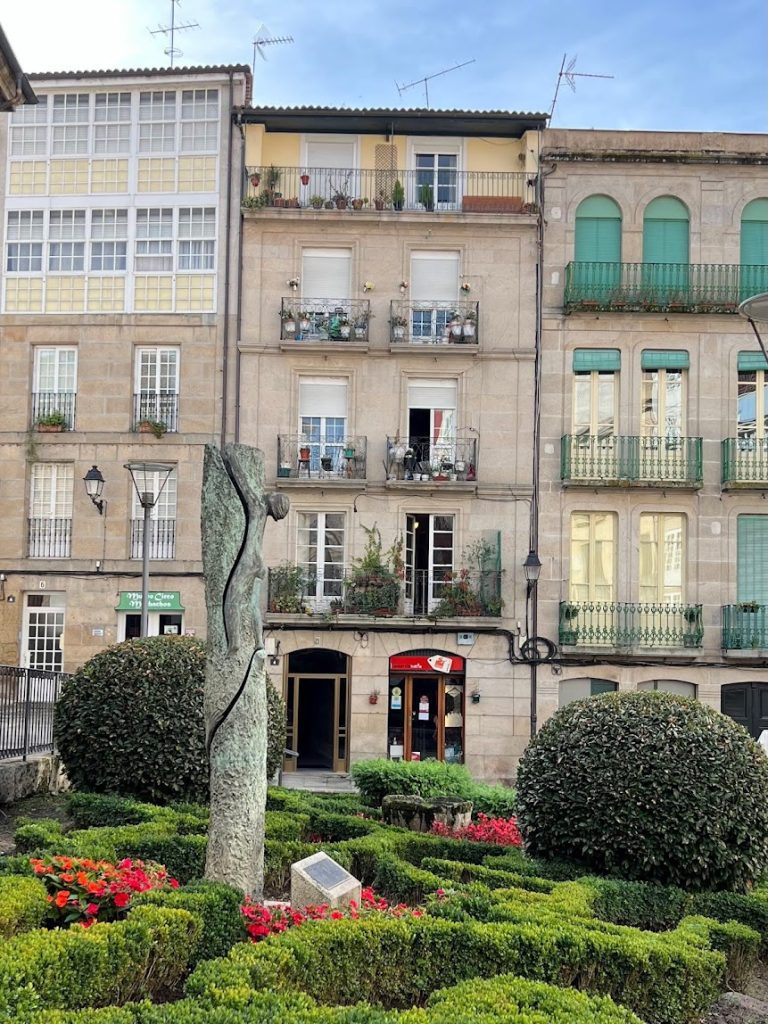

Waiting for the train. Don’t look now but the forecast in Pontevedra is calling for rain, rain, and more rain.

